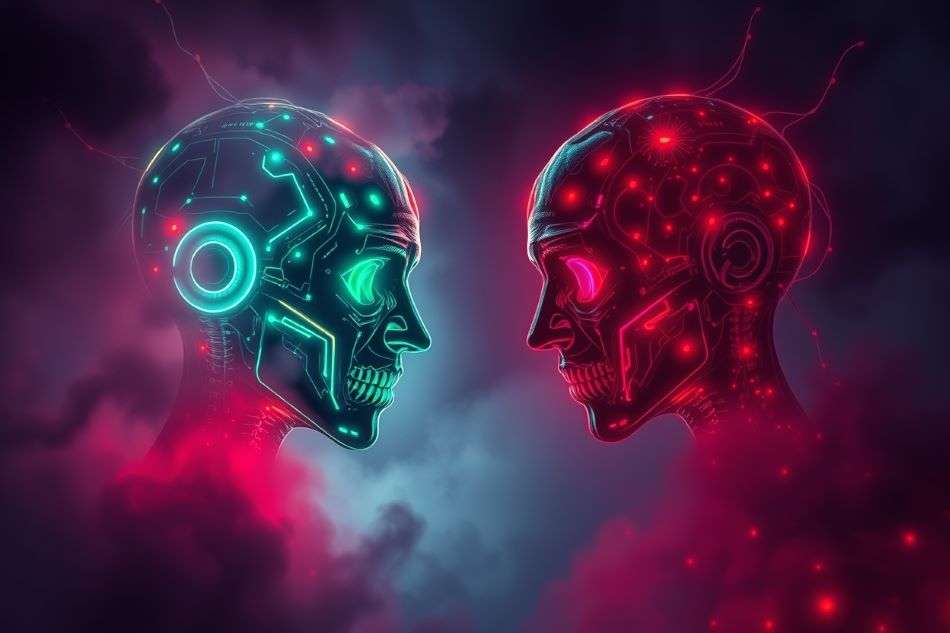GPT-3 Chatbot and Beyond – AI Chatbots are the key to exceptional customer service
In the digital age, customers demand quick and personalized interactions with businesses, which is why chatbots and AI are essential. Join us as we explore their benefits, successful use cases, and challenges in this rapidly-evolving field.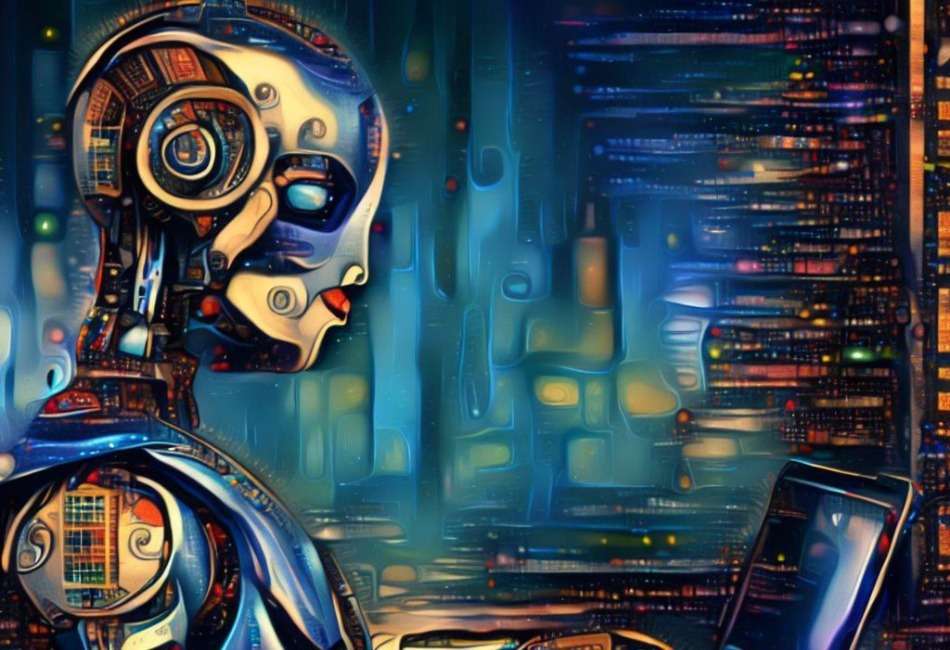
Personalized Interactions at Scale: How Chatbots and AI Are Shaping Customer Care
In today’s fast-paced digital age, customers expect nothing less than quick, efficient, and personalized interactions with businesses. This is where chatbots and artificial intelligence (AI) come in. There is more than just the hype created by the initial GPT-3 Chatbot in 2022 that took the internet world by storm, it is a technology that will change the world as we know it. By leveraging these technologies, companies can provide round-the-clock customer support, improve response times, and even gather valuable data for future improvements. In this article, we’ll explore the benefits, types, and successful use cases of chatbots and AI in customer service, as well as the challenges that come with their implementation.
Definition of Chatbots and AI in Customer Service
Chatbots are computer programs designed to mimic conversation with human users, especially over the internet. They use natural language processing (NLP) to understand the user’s query and provide a suitable response. Artificial intelligence (AI) in customer service involves the use of chatbots, machine learning, and other technologies to automate and improve customer support.
The Importance of AI Chatbots in Customer Service
Chatbots and AI have transformed the way businesses handle customer support. They have made it possible to provide 24/7 assistance, improve response times, reduce costs, and personalize interactions with customers. By automating mundane tasks, businesses can focus on more complex customer queries, leading to higher customer satisfaction and loyalty.
Brief history of Chatbots and AI in customer service
The idea of a machine that can communicate with humans is not new. The first chatbot was created in 1966 by Joseph Weizenbaum, a computer scientist at MIT. He developed a natural language processing program called ELIZA, which simulated conversation by responding to user input with pre-written scripts. In the following decades, chatbots have become more sophisticated and widespread, with businesses using them to provide customer service and support.
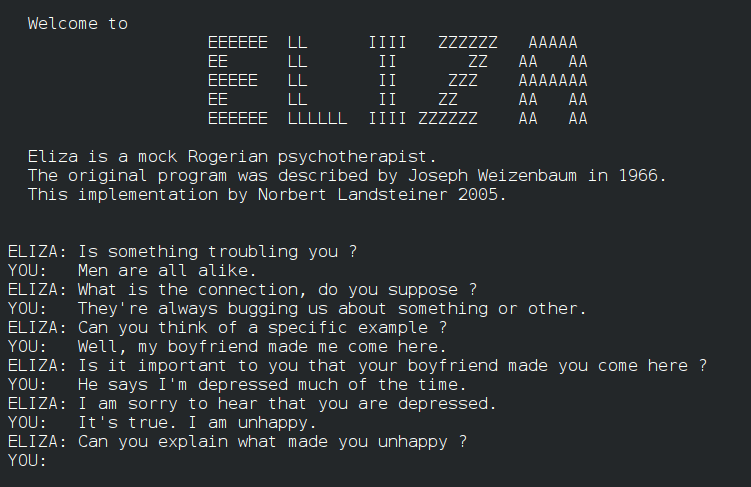
The first chatbot used for customer service was launched in 2011 by Amtrak, a US-based railway company. Since then, many businesses have followed suit and adopted chatbots as a means of communication with their customers. The use of chatbots has become increasingly popular due to the advancements in AI and natural language processing technology.
The launch of the GPT-3 chatbot in 2022 has boosted the AI Chatbots into the mainstream and has democratized the usage of AI technology for small companies, as well as creating new business opportunities. There are many new AI Chatbots that are built on the GPT-3 Algorithm such as Helpshift and Ada, as well as big players that are developing their own chatbots such as Salesforce Einstein and IBM Watson Assistant.
The Benefits of Chatbots and AI in Customer Service
24/7 Availability – Delivering uninterrupted support to customers around the clock
One of the most significant benefits of using chatbots and AI in customer service is the ability to provide 24/7 support. Traditional customer service methods often have limited availability, with customers having to wait until business hours to speak with a representative. With chatbots, customers can get the help they need at any time, day or night.
Improved Responses- Accelerating customer service response time with AI Chatbots
Another benefit of using chatbots and AI in customer service is the improved response time. Chatbots are programmed to respond to customer inquiries quickly, reducing the time customers have to wait for a response. This not only enhances customer satisfaction but also reduces the workload of human customer service representatives.
Cutting costs with chatbots: How AI is streamlining customer service operations
Chatbots and AI can help businesses save money by reducing the cost of customer service operations. By automating simple inquiries and tasks, chatbots can reduce the workload of human representatives, allowing them to focus on more complex issues. This also means that businesses can operate with a smaller customer service team, saving on staffing costs.
Built to scale: How AI Chatbots ensure consistent customer service during business growth
Chatbots and AI can also help businesses scale their customer service operations. As the volume of customer inquiries increases, businesses can easily scale up their chatbot operations to handle the increased workload. This scalability ensures that customers receive a consistent level of service, even during periods of high demand.
Customer-Centric Service: How AI Chatbots can deliver personalized support
Chatbots and AI can provide a more personalized customer service experience by using customer data to tailor responses and interactions. By analyzing customer behavior and preferences, chatbots can provide personalized recommendations and solutions, making customers feel valued and understood.
The Data Goldmine: How AI Chatbots can help businesses gather valuable customer Information
Chatbots and AI can also collect valuable data on customer behavior, preferences, and pain points. This data can be used to improve customer service operations and inform business decisions, such as product development and marketing strategies.
KEY TAKINGS OF AI CHATBOTS:
- AI Chatbots provide 24/7 availability, allowing customers to receive support at any time
- AI Chatbots improve response time, allowing customers to receive assistance quickly
- AI Chatbots can reduce costs for businesses by handling a large volume of customer inquiries
- AI Chatbots can scale up to handle high volumes of inquiries without needing additional staff
- AI Chatbots can provide personalized responses to customers, improving the customer experience
- AI Chatbots can collect data on customer interactions, allowing businesses to gain insights into customer behavior
Pro tip: Use AI chatbots to personalize and streamline customer service, collect valuable data, reduce costs, and scale operations. Benefit from 24/7 availability and improved response times.
AI Chatbot types: Which one is right for your business?
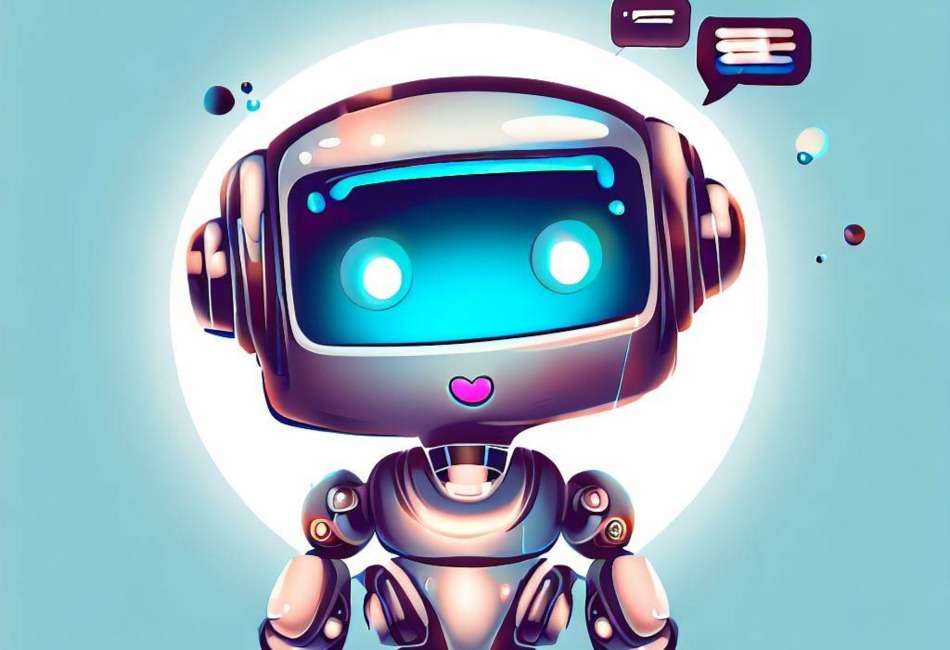
Rule-based Chatbots:
Rule-based chatbots are programmed to follow a set of pre-defined rules and can only provide answers to questions that they have been programmed to recognize. They are limited in their ability to handle complex queries and require constant updating to remain accurate. These chatbots are best suited for handling simple, straightforward queries and are typically used in situations where the answers are predictable and follow a set pattern.
AI-powered Chatbots:
AI-powered chatbots use natural language processing (NLP) and machine learning algorithms to understand and respond to customer queries. They are capable of handling complex queries and can learn and improve their responses over time. These chatbots are highly adaptable and can work across different industries and languages. They can be programmed to understand different accents, colloquialisms, and even sarcasm. AI-powered chatbots are more sophisticated than rule-based chatbots but require more initial development and training to achieve their full potential.
Hybrid Chatbots
Hybrid chatbots combine the best of both rule-based and AI-powered chatbots. They use a combination of predefined rules and natural language processing algorithms to provide a more human-like conversation while still being able to handle more complex queries.
The benefit of hybrid chatbots is that they can handle a wide range of queries, from simple to complex, and provide personalized responses based on the user’s history and behavior. They are also better equipped to handle a conversation when it shifts from a specific task or issue to a more general conversation.
One successful example of a hybrid chatbot is the “Ask Mercedes” chatbot. It is a virtual assistant that helps Mercedes-Benz customers with vehicle-related questions and issues. The chatbot uses natural language processing and machine learning to understand and respond to customer queries, while also incorporating pre-defined rules for specific tasks.
| Type of Chatbot | Pros | Cons |
|---|---|---|
| Rule-based | – Best suited for handling simple, straightforward queries – Can provide accurate and consistent responses – Easy to set up and maintain | – Limited in their ability to handle complex queries – Require constant updating to remain accurate – Cannot provide personalized responses |
| AI-powered | – Capable of handling complex queries – Can learn and improve responses over time – Highly adaptable and can work across different industries and languages | – Require more initial development and training to achieve their full potential – May have difficulty understanding colloquialisms and sarcasm – May provide inconsistent or inaccurate responses if not trained properly |
| Hybrid | – Can handle a wide range of queries – Can provide personalized responses based on user history and behavior – Can provide a more human-like conversation | – May be more complex to set up and maintain – May have higher development and training costs – May require more sophisticated technology to integrate rule-based and AI-powered systems |
KEY TAKINGS OF CHATBOTS TYPES:
- Rule-based chatbots follow pre-determined rules and can only respond to specific questions
- AI-powered chatbots use machine learning algorithms to understand and respond to natural language queries
- Hybrid chatbots combine both rule-based and AI-powered approaches to provide more accurate and efficient responses
Mastering customer service with chatbots – How do they work?
Breaking the language barrier: How Chatbots use NLP to understand customer queries
Chatbots work by using natural language processing (NLP) to understand customer queries. NLP is a branch of artificial intelligence that focuses on the interaction between computers and human languages. It allows chatbots to understand the meaning behind words and phrases, as well as the context in which they are used.
To understand customer queries, chatbots use various NLP techniques such as named entity recognition, sentiment analysis, and intent recognition. Named entity recognition helps chatbots to identify specific entities such as names, places, and dates, while sentiment analysis helps them to understand the emotional tone of the customer’s message. Intent recognition helps chatbots to determine the purpose of the customer’s message, and identify the specific action that needs to be taken.
From Data to Solutions: The Role of Machine Learning Algorithms
Once chatbots have understood the customer’s query, they use machine learning algorithms to provide a personalized solution. Machine learning is a subset of artificial intelligence that uses statistical techniques to enable computers to learn from data, without being explicitly programmed.
Machine learning algorithms enable chatbots to learn from customer interactions and continuously improve their responses. They can also use historical data and customer behavior patterns to provide more accurate and relevant solutions.
One of the most used model is the GPT-3 chatbot, a state-of-the-art language processing AI model developed by OpenAI, which provides the infrastructure and data to build personalized AI chatbots for businesses of different scales. The model has evolved to GPT-3.5, GPT-3.5 Turbo and the latest release of Open AI with enhanced capacities, yet with limited accessibility by the general public: GPT-4.
Seamless handover: How AI Chatbots work with human agents to provide exceptional customer service
In some cases, chatbots may not be able to provide a satisfactory solution to the customer’s query. In such cases, they can transfer the conversation to a human agent for further assistance. This is known as chatbot escalation.
Chatbot escalation ensures that customers are not left stranded or frustrated with the conversation, and that their queries are resolved in a timely and effective manner. It also allows human agents to handle more complex queries that may require a higher level of expertise.
KEY TAKINGS ON HOW AI CHATBOTS WORK:
- Chatbots use natural language processing (NLP) to understand customer inquiries
- Chatbots can provide solutions to customer inquiries based on pre-determined rules or through machine learning algorithms
- Chatbots can transfer the conversation to a human agent if the query cannot be resolved
The bumpy road ahead: The challenges of implementing Chatbots in customer service
Despite the benefits, there are several challenges to implementing chatbots and AI in customer service. Technical limitations can arise, such as the inability of chatbots to understand complex queries or the difficulty in integrating chatbots with existing systems. Data privacy and security are also a concern, as chatbots collect sensitive customer information that must be protected. Additionally, customers may not accept chatbots as a replacement for human interaction, leading to resistance and a negative perception of the company.
Furthermore, chatbots may lack the empathy and emotional intelligence of human agents, leading to a diminished customer experience. In some cases, customers may be frustrated with chatbots, leading to an escalation of the issue and the need for a human agent to intervene. As a result, it is important to strike a balance between chatbots and human agents, ensuring that chatbots are used to augment human capabilities rather than replace them entirely.
KEYPOINTS ON THE CHALLENGES OF AI CHATBOTS:
- Technical limitations can make it difficult to implement chatbots and AI
- Data privacy and security concerns can arise when collecting customer data
- Customers may not accept or trust chatbots, preferring human interaction
- Lack of human interaction can be a challenge for chatbots, as they may not be able to provide the empathy and emotional support that some customers require.
The Chatbot Revolution: What Lies Ahead for Customer Service
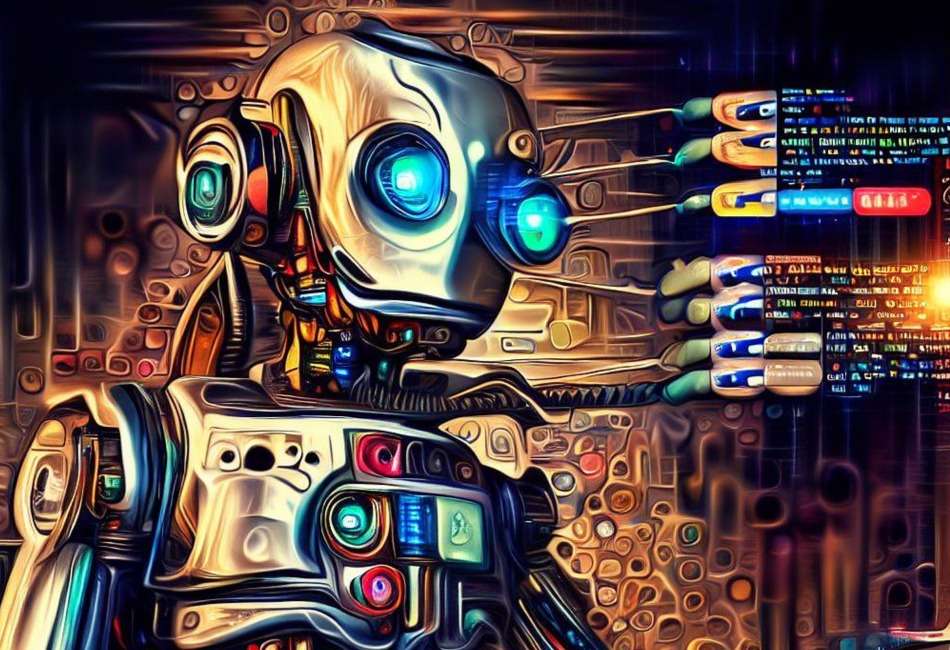
Looking to the future, the advancements in natural language processing and machine learning are expected to lead to even more sophisticated chatbots and AI in customer service. Increased personalization is also on the horizon, as chatbots will be able to access more data about customers and provide tailored recommendations and solutions. The integration of chatbots with voice assistants is also becoming more prevalent, as customers can engage with chatbots through voice commands.
Moreover, the use of chatbots and AI in customer service is expanding to other industries beyond retail and banking. Healthcare providers are leveraging chatbots to assist with appointment scheduling and symptom assessment, while hospitality companies are using chatbots for concierge services and personalized recommendations.
The future of AI looks bright, with advanced chatbots and innovative customer service solutions on the horizon. From smaller players in the field and new exciting tech start ups to bigger players such as IBM Watson Assistant and Salesforce Einstein, who uses proprietary AI technology while incorporating the latest advancements in the field from Google, Microsoft and OpenAI. The possibilities for AI-powered customer service are endless, and we can expect exciting developments in the coming years.
There are plenty of AI Chatbots to choose from depending on your business needs, budgets and the Aims you are looking to achieve. Some popular options include:
Ada: An AI-powered chatbot ideal for automating simple, repetitive tasks like FAQs, scheduling appointments, and providing basic information in industries such as healthcare, retail, and finance.
ADA AI Chatbot provides an easy-to-use no-code builder and drag-and-drop UI, which makes it easy for businesses to set up and deploy their chatbots.
The software offers advanced resolution engine that can extract relevant conversation and customer details to provide personalized support.
With prebuilt workflows and generative AI for automated actions, ADA AI Chatbot can handle complex inquiries and resolve them in real-time.
Multimodal support for digital and voice channels provides customers with a range of options for contacting the business and resolving their issues.
Multilingual support for resolving inquiries in over 50 languages makes it easy for businesses to communicate with their global customers.
Some users may find the software expensive, particularly for small businesses or those on a tight budget.
Integration with some third-party systems may require additional setup and configuration.
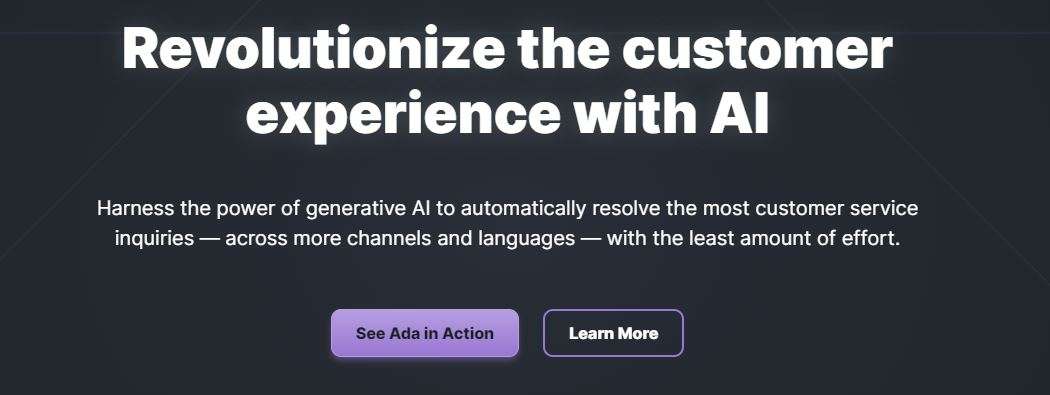 Home Page
Home Page
- No-code automation builder and drag-and-drop UI
- Multimodal support for digital and voice channels
- Generative content creation for conversational FAQs
- Integration with existing business systems to resolve complex inquiries
- Advanced resolution engine that extracts relevant conversation and customer details
- Prebuilt workflows and generative AI for automated actions
- Out-of-the-box integrations with CRMs, MAPs, and ecommerce software
- Multilingual support for resolving inquiries in 50+ languages
- Comprehensive reporting for tracking resolution rate, intent recognition accuracy, and other performance metrics
IBM Watson Assistant: An AI-powered chatbot platform that excels in handling complex queries and providing personalized responses, suited for industries like banking, insurance, and telecommunications.
It is easy to use, without coding knowledge required.
It helps create virtual assistants in a matter of hours or days, depending on workflows complexity.
It creates internal and operational efficiencies with faster ROI.
Offers a high level of protection to keep customer data safe and secure.
Improve customer experience and limits frustration from limited capabilities Chatbots.
It can be a complex tool to navigate, particularly for those without technical experience or expertise.
Watson Assistant can be customized to some extent, it may not have the same level of customization options as some other chatbot platforms.
Watson Assistant relies heavily on artificial intelligence, which can sometimes lead to inaccuracies or errors in responses, especially if is something very specific.
IBM Watson Assistant is not the most affordable chatbot platform on the market, and its pricing structure may be prohibitive for some businesses or organizations.
- AI-powered virtual agent that provides fast, accurate answers to customer inquiries
- Natural language processing and machine learning capabilities that allow Watson Assistant to learn from customer conversations and improve its responses over time
- Ability to be deployed on any cloud or on-premises environment
- Built-in protection to keep customer data safe and secure
- Can integrate with other IBM Watson services, such as Watson Discovery, to improve search capabilities
- “Actions” feature that allows users to create simple and advanced workflows to answer customer questions and handle complex tasks
- Offers support for multiple languages to serve a global audience
- Customizable user interface to fit the brand and style of your business
- Comes with a variety of pre-built templates and integrations to accelerate the virtual agent development process.
Salesforce Einstein: An AI-powered chatbot platform that is ideal for handling customer inquiries and support tickets in industries like e-commerce, healthcare, and finance, with a focus on complex queries and personalized responses. It integrates with other Salesforce tools for a seamless customer experience.
The NLP capabilities are very accurate and can understand complex customer inquiries.
The ability to customize the chatbot's responses allows businesses to provide a more personalized customer experience.
Seamless integration with Salesforce's other CRM tools makes it easy to manage customer interactions.
Multi-channel support ensures that customers can get assistance no matter where they are.
Advanced analytics provide insights into customer behavior and help improve the chatbot's performance over time.
Setting up the chatbot can be time-consuming, and may require help from Salesforce's technical support team.
The pricing for the AI Chatbot feature can be expensive, especially for smaller businesses.
While the NLP capabilities are impressive, the chatbot may still struggle with certain complex inquiries.
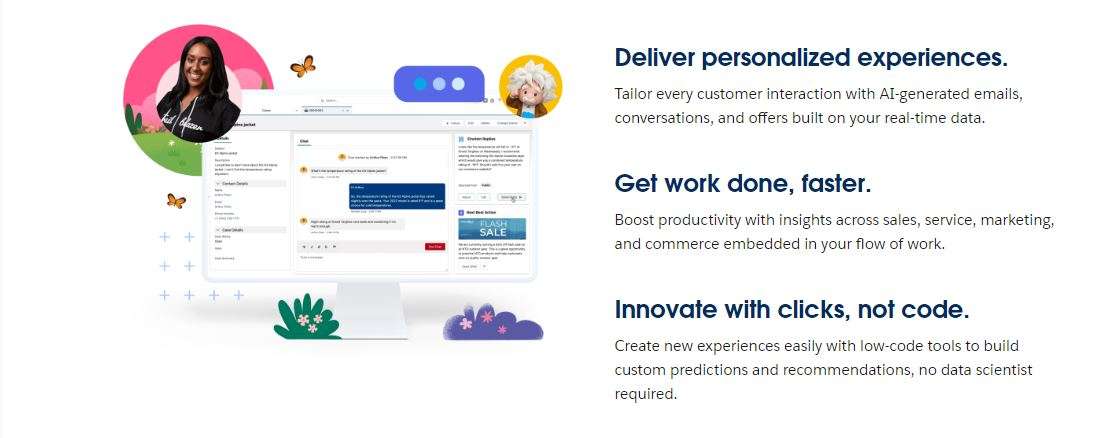 Salesforce Einstein
Salesforce Einstein
- Natural Language Processing (NLP) capabilities for accurate interpretation of customer inquiries.
- Ability to customize the chatbot’s responses to specific customer needs.
- Seamless integration with Salesforce’s other customer relationship management (CRM) tools.
- Multi-channel support, including web, mobile, and social media platforms.
- Advanced analytics to track performance and improve the chatbot’s effectiveness.
- SalesForce Einstein is the Artificial Intelligence that is supporting a large suite of services and tools designed for Business Operations
ManyChat: A chatbot platform that specializes in Facebook Messenger marketing. It offers a drag-and-drop chatbot builder, as well as integration with popular marketing tools like Zapier, Mailchimp, and Shopify.
Trusted by over 1 million businesses to power over 1 billion customer conversations.
Click-through rates are 130% higher than the industry average.
Easy to use and integrates with popular tools such as Google Sheets, Shopify, and HubSpot.
Seamless Integration with Facebook / Instagram.
The pricing is based on the number of contacts
Limited Integrations outside the scope of Social media
Analytics are not as insightful as other AI Chatbots
- Offers access to Instagram Direct Messages, Facebook Messenger, WhatsApp, and SMS text messaging.
- Allows users to build automation quickly using a visual drag n’ drop interface.
- Enables businesses to combine SMS and email to capture phone numbers or emails in automation.
- Offers unlimited custom flows, growth tools, keywords, team member seats, tags, custom fields, and advanced segments in its Pro plan.
- Provides analytics and insights tools in its Pro plan.
Keep an eye on the latest AI Tools thoroughly reviewed by our TechPilot experienced team and get in touch with us if you are building an exciting project that you would like us to review.
Successful Use Cases of Chatbots and AI in Customer Service
Airbnb
Airbnb, the online marketplace for vacation rentals, has successfully implemented a chatbot called “Airbnb Assistant”. The chatbot provides users with personalized recommendations for places to stay and things to do, based on their preferences and search history. It also helps users to manage their bookings, answer frequently asked questions, and resolve issues.
The Airbnb Assistant chatbot has reduced response times and improved customer satisfaction, while also freeing up human agents to handle more complex queries.
H&M
H&M, the multinational clothing retailer, has implemented a chatbot called “H&M Chabot”. The chatbot provides users with personalized style recommendations, based on their preferences and style choices. It also helps users to find products, track orders, and answer frequently asked questions.
The H&M chatbot has increased customer engagement and reduced response times, while also providing a unique and personalized shopping experience for users.
Pizza Hut
Another successful use case of chatbots and AI in customer service is Pizza Hut. The restaurant chain launched a chatbot on Facebook Messenger to allow customers to place orders, track deliveries, and ask for assistance. The chatbot’s natural language processing capabilities enable it to understand customers’ requests and provide personalized recommendations based on their previous orders and preferences. Pizza Hut reported a 20% increase in sales through the chatbot, indicating the high level of customer engagement and satisfaction.
Bank of America
Bank of America, the multinational banking and financial services corporation, has implemented a chatbot called “Erica”. The chatbot provides users with personalized financial advice, based on their spending patterns and account history. Erica is powered by AI and can perform tasks such as checking account balances, transferring funds, and paying bills.
One of the key benefits of Erica is its ability to learn from user interactions and provide more personalized recommendations over time. For example, if a user frequently spends money on travel, Erica might suggest travel rewards credit cards or offer tips on how to save money while traveling.
In addition to providing personalized financial advice, Erica also offers a seamless customer service experience. Users can ask questions about their accounts, report fraud, or even schedule appointments with a banker directly through the chatbot.
Since its launch in 2018, Erica has proven to be a successful addition to Bank of America’s customer service strategy. As of 2021, Erica has over 18 million users and has processed over 120 million requests.
Bank of America has stated that the implementation of Erica has not only improved customer satisfaction but has also led to cost savings for the company. By automating routine tasks and reducing the need for human customer service representatives, Bank of America has been able to reduce operational costs.
Overall, the success of Erica demonstrates the potential for chatbots and AI in customer service to not only provide a more personalized experience for users but also to streamline business operations and save costs.
Conclusion – AI Chatbots are here to stay for the foreseeable futures and they will only getting better!
In conclusion, chatbots and AI have proven to be valuable tools in customer service, providing 24/7 availability, improved response times, cost reduction, scalability, personalization, and data collection. While challenges remain, the future of chatbots and AI in customer service is bright, with advancements in natural language processing, machine learning, and personalization on the horizon. As companies continue to integrate chatbots and AI into their customer service strategies, it is important to strike a balance between chatbots and human agents, ensuring that customers receive the best possible experience.
Learn more about how technology has changed the business landscapes in the age of Artificial intelligence and how you can stay ahead of the curve by using AI in Marketing, Social media and Automating your Marketing processes to save time and resources. Follow our blog for the latest AI Trends that surely will change the future as we see it today.







